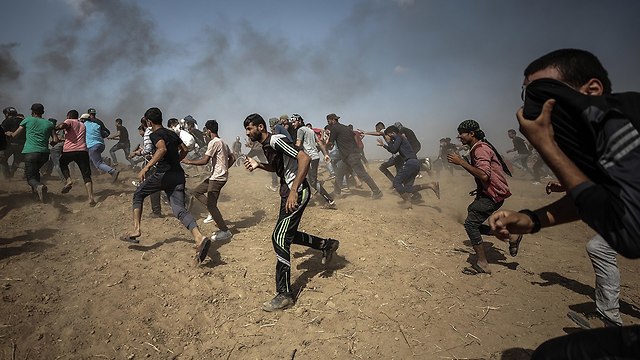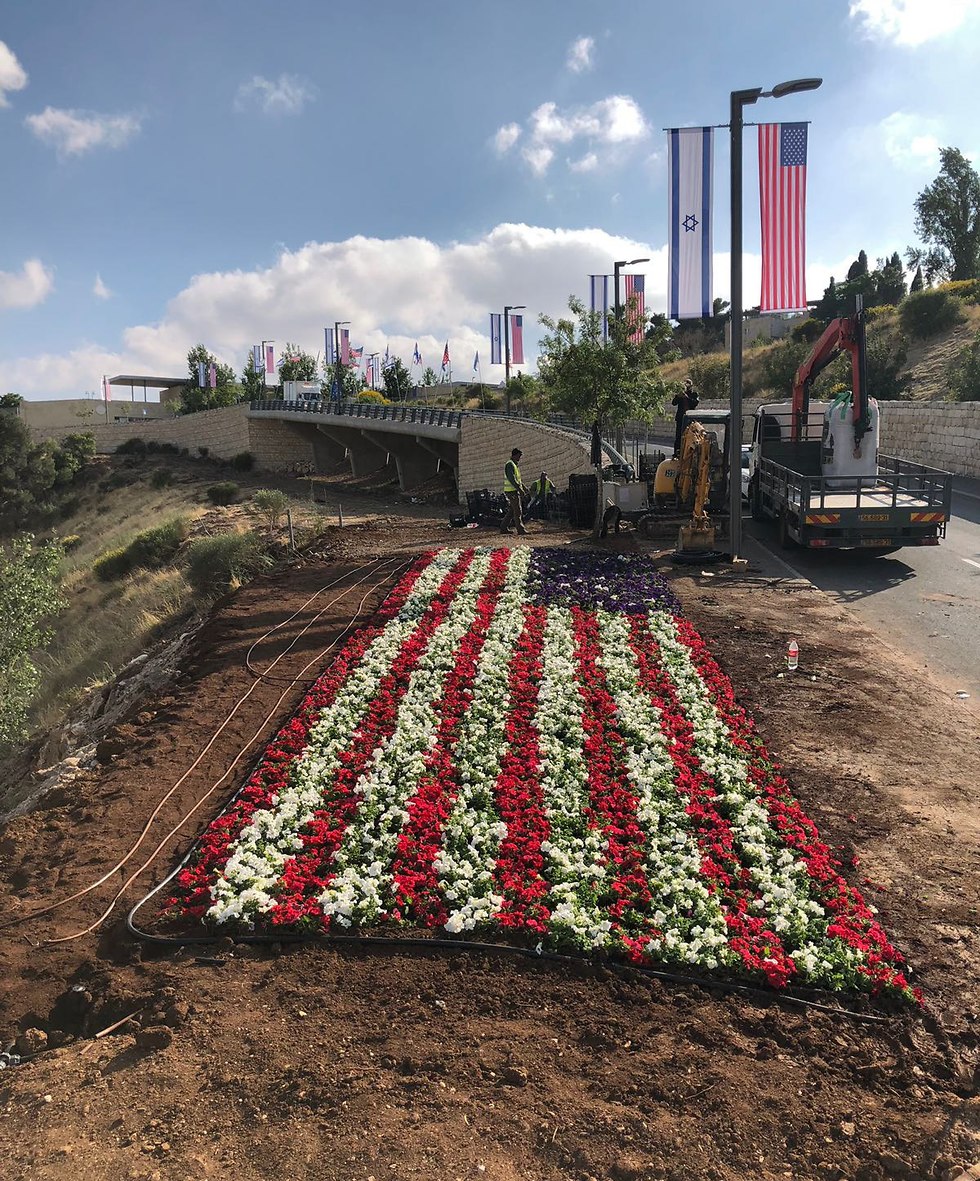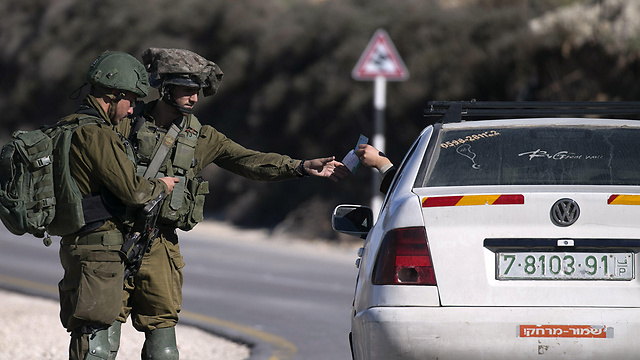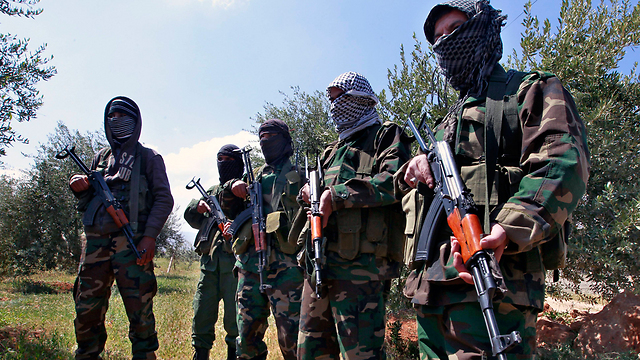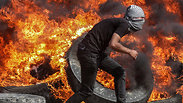
Between Tehran and Gaza: From the dangerous threat to the explosive threat
Analysis: Iran’s ayatollahs and media fell for Qassem Suleimani’s ‘fake news’ about the deaths and serious damage his forces inflicted on Israel, but the Quds Force commander knows the truth—and that’s what counts. Meanwhile, the IDF is working to prevent new conflict in the strip by wearing out the ‘human tsunami’ before it reaches the fence area.
The US Embassy will open in an official ceremony in Jerusalem on Monday. The following day, the Palestinians will mark Nakba Day. The Ramadan fast will begin Wednesday night, and the “March of Return” will take place in the Gaza Strip on Friday.
The IDF and police are preparing for major physical clashes with crowds of young Palestinians. The residents of the Gaza vicinity, Jerusalem and Judea and Samaria should prepare for the coming week as well, to reduce friction with the Palestinians and keep the potential death toll low.
Israel’s main goal, and the IDF’s core mission, is to prevent hundreds and perhaps thousands of Palestinians from infiltrating Israeli territory from Gaza and reaching communities in the western Negev.
In the West Bank, the core mission is to prevent terror attacks with firearms and cold weapons, as well as community infiltrations. So far, there is no apparent trend of an escalation in the West Bank, an arena which has remained calm in recent weeks even when the situation in Gaza escalated and young Gazans lost their lives on the fence. There are no indications or warnings of a flare-up in Jerusalem as well, for now.
In Jerusalem, the security forces’ mission is to prevent a “religionization” of the conflict with the Palestinians. Clashes with an angry crowd and terror attacks over the Muslim holy sites and around them will extend and intensify the conflicts, stir up things in the Muslim world (including Egypt and Jordan) and could even lead to border attacks from Lebanon, Syria and Sinai.
History shows it’s almost impossible to put out a fire started by religion. Religious violence erupts time and again and claims many victims. A religiously-motivated conflict could also lead to terror attacks against Israelis and Jews around the world.
The religious motive has been working for years in the service of the Iranian Quds Force, and the force’s leader, Qassem Suleimani, may take advantage of the flare-up in the Muslim world following riots in Jerusalem to further a terror attack abroad and retaliate the victims among his people and the humiliations he has suffered from Israel in recent weeks in the Syrian Golan Heights.
Defense establishment officials are aware of all of this and are taking several measures to guarantee that the missions are accomplished in the three Palestinians arenas with zero victims on the Israeli side and by avoiding killing unarmed Palestinians, as long as they don’t pose a clear and present danger to our forces or to Israeli citizens.
The reason isn’t just ethical but also practical: Experience shows that a death toll of dozens and perhaps hundreds of Palestinians from IDF and police fire will only intensify the violence and the motivation to carry out terror attacks and may lead to a new wave of terror and possibly even to an intifada that will spill into Israeli territory.
Another important reason is that a lot of deaths among the Palestinians will push Israel into a difficult PR, diplomatic and legal corner—and this is exactly what Hamas leader Ismail Haniyeh and Palestinian President Mahmoud Abbas are trying to do. As a result, Israel will become isolated and may face boycott initiatives and attempts to prosecute IDF officers in the International Criminal Court (ICC) in The Hague. This will gradually reduce Israel’s legitimacy to defend itself and it may even be slapped with sanctions in the international arena.
Boosting forces and using technological means
The most important measure used by the security and law enforcement authorities is a massive boost of the forces along the Gaza border fence and between the fence and the Gaza vicinity communities, as well as in Judea and Samaria: Dozens of squadrons of qualified fighters from the IDF’s regular field units will be stationed in possible friction areas, in addition to units on routine security missions. Other units will be stationed on the ground or put on a heightened state of alert as reserve forces. The large number of regular fighters in every point of friction will serve as a “blanket” that will be throw on the fire to suffocate it—a measure which has proved itself in the past.
Furthermore, the army will use technological means to disperse the crowd and control it, including portable fences that can easily be erected, psychological warfare, etc. All the forces that have already been dispatched to the Gaza border or to the West Bank and the ones that will arrive there later, including elite units, have undergone specific training in the Central Command and Southern Command bases, where they learned to confront and take over an unruly crowd.
As part of the effort to prevent Palestinian casualties and unnecessary shooting, senior officers have been stationed in every point of friction and next to the snipers. They are the only ones authorized to give the soldiers permission to shoot if they are not in clear and present danger.
For the same reason, reserve units haven’t been called up to take part in the direct conflict with the unruly crowds. The reserve soldiers are excellent fighters when it comes to conventional fighting against an armed enemy, but most of them are unaccustomed to and have no experience with a close-range conflict with a wild crowd throwing Molotov cocktails and stones. As a result, many of them stress out and push the trigger unnecessarily.
The main concern is that thousands and perhaps tens of thousands of Palestinians will run towards the border fence as part of the “March of Return” on Nakba Day and on the following days. Hamas is going to great lengths to get more and more people to take part in the march, knowing that a large number of people storming the fence is likely to lead to a high death toll and harm Israel both internally and internationally.
The security forces are planning to wear out the “human tsunami” wave with different measures before it reaches the fence area, in a bid to reduce and control the number of Palestinians storming the fence. These measures can’t and shouldn’t be specified, to prevent Hamas from preparing an effective response.
In Judea and Samaria, the IDF has been focusing on prevention measures every single night: Conducting arrests by using intelligence and warnings gleaned from social media and public information on the Web. When the conflicts begin on the ground, and possibly earlier, the combat intelligence collection system will be activated too. The collection of intelligence through ground and aerial observations will make it possible to quickly locate points and friction and weak spots created during the events and send reinforcement to those areas.
Meanwhile, the army is working to continue the separation and distinction between actual and potential terrorists and the uninvolved population which doesn’t wish to get involved. Efforts are being made to prevent the terrorists—Hamas people or Palestinians inspired by social media and “shahidim” who serve as their role models—from executing their plans.
At the same time, the plan is to allow the uninvolved population to continue its routine life and move freely on the traffic routes. This is where Judea and Samaria settlers must plan an active role: They must help the Shin Bet and IDF restrain the “price tag” rioters and, if necessary, block them themselves. In this case too, the reason isn’t just ethical but mainly practical: Jewish rioters endanger Judea and Samaria settlers in their activities, which increase both the Palestinian incitement and the criticism against Israel in the international arena.
The Palestinian security apparatuses have been instructed by Abbas to coordinate their activities and work together with the Israeli forces. The fact that the order is being implemented proves that Abbas still holds full control over his people despite the cognitive weakness he has been demonstrating latterly in his anti-Semitic speeches.
Even when he isn’t at his best, Abbas knows that the cooperation between the Palestinian security apparatuses and their Israeli counterparts is vital for both sides. The Shin Bet and IDF want to prevent terror attacks initiated and encouraged by Hamas against Israel, while Abbas has an existential interest in stopping Hamas from taking over the West Bank. Both sides are also interested in preventing the protests and riots from spinning out of control, a situation which could threaten the Palestinian Authority’s survival.
IDF Chief of Staff Gadi Eisenkot, Police Commissioner Roni Alsheikh, Shin Bet Director Nadav Argaman and their organizations’ top officials have already prepared the infrastructure, built up strength, trained the forces and decided on the modus operandi. The implementation, however, requires great skills as well as caution and experience from the commanders on the ground, who are operating under Gaza Division Commander Brigadier-General Yehuda Fuchs and Judea and Samaria Division Commander Brigadier-General Eran Niv. These two officers, alongside the Southern Command and Central Command chief, will largely determine how the State of Israel passes this test—both the physical test and the perceptual and diplomatic test.
Summary of the Iranian round
A moment before the Israeli public opinion shifts its focus and concerns from the more dangerous threat (Iran) to the more explosive threat (the Palestinians), we should take a moment to understand how the “Iranian round” ended last week and what might happen in the future.
The good news is that the ayatollah regime and its power base, the Revolutionary Guards, were dealt two painful blows last week. The first was a strategic blow from US President Donald Trump, who announced an American withdrawal from the nuclear agreement between Iran and the world powers. Immediately after the Washington declaration, the Iranian rial tumbled, reaching a record low. In other words, the income and savings of millions of Iranians were slashed within hours, threatening the regime’s survival in the long run.
The second, tactical blow, came from the IDF against the Revolutionary Guards and the Quds Force in Syria. The limited retaliation and deterrence operation that was planned by Qassem Suleimani against military targets in Israel was disrupted and eventually thwarted altogether thanks to the right combination between high-quality and accurate intelligence in real time, military and diplomatic discretion and activity, as well as the Air Force’s excellent planning and performance abilities.
While Suleimani managed to sell his bosses in Tehran a classic “fake news” story about deaths and serious damage his forces allegedly inflicted on Israel, and although Ayatollah Ali Khamanei and the Iranian media likely fell for it, Suleimani knows the truth—and that’s what counts.
The good news is that Russian President Vladimir Putin has restored his original approach towards the relations with Israel which he had adopted at the start of the Russian involvement in Syria in 2015. Putin, who is very unhappy with the fact that NATO has placed sophisticated antiaircraft and antimissile systems on his country’s borders, has referred to it several times as an aggressive Western move.
Putin was likely quite satisfied, therefore, when Prime Minister Benjamin Netanyahu and Minister Ze’ev Elkin told him that the Israel Air Force had destroyed Iranian-made antimissile systems, which are remarkably similar to the Russian S-300 system, after they were placed on Israel’s border. Putin doesn’t appreciate competition and has high regard for force. This was reflected not only in the way he honored the Israeli prime minister during the Moscow parade, but also in his decision to suspend the supply of the S-300 system to Syria.
Another positive development, as far as Israel is concerned, is the fact that Hezbollah has no intention of intervening in the conflict for now and using its missile arsenal and special forces to help the Iranian military entrenchment in Syria. In other words, the Israeli deterrence is working, particularly since Israel made it clear that “Hezbollah equals Lebanon.” This means that in the next war, Israel will make no distinction between Hezbollah and the state of Lebanon its infrastructure. If Hezbollah’s missiles and rockets hit Israel, the damage inflicted on all of Lebanon will be disproportional.
This was explained very well recently by Education Minister Naftali Bennett, a member of the Political-Security Cabinet: “There is no point in running after every Hezbollah rocket and after every Hezbollah missile launcher. It would also be a mistake to fight Hezbollah alone. We must fight the entire state of Lebanon, in Baalbek and in the villages of southern Lebanon, which is allowing Hezbollah to fire thousands of missiles on the citizens of the State of Israel.”
Bennett has rich experience in fighting in Lebanon, and his perception is likely accepted by the rest of the cabinet members, especially after Hezbollah reifnroced its effective control over the parliament and the government in Beirut following last week’s elections in Lebanon.
Syrian President Bashar Assad is likely unsatisfied either with the conflict waged by the Iranians against Israel from his country’s territory. The bottom line is that Suleimani and his people are alone in this story.
We shouldn’t get caught in the euphoria, however, as there is bad news as well. It’s already clear that the serious blows suffered by the Iranians last week weren’t enough to change the regime and Revolutionary Guards’ vision and objectives in any way. They haven’t given up their nuclear aspirations, their ambition to reach an Iranian-Shiite hegemony in the Middle East and the desire to destroy the State of Israel by military entrenching themselves in Syria.
The Iranians have simply taken a timeout to recalculate their route. As a result, Israeli officials were able to order the closure of bomb shelters in the Golan Heights over the weekend and estimate that the current round with the Iranians has been put on hold.
Suleimani likely hasn’t given up his plan to create a military front against Israel in Syria which would operate in addition to the Lebanese front, and separately too if necessary. He has also noticed Hezbollah leader Hassan Nasrallah’s growing independence in Lebanon. All signs indicate that Suleimani hasn’t given up his desire to take revenge against Israel and that he will likely try to target Israelis and Jews abroad.
In any event, we should remember that the Shiites in general, and the Iranians in particular, are filled with a sense of self-victimization. This mentality contains an important advantage: Because they are prepared for the blows in advance, they recover quickly and move on. It’s difficult to deter them or divert them from their path. So our conflict with the ayatollahs and with the Revolutionary Guards hasn’t ended in the current round and won’t end in the following round either. The same applies to the conflict with the Palestinians.










